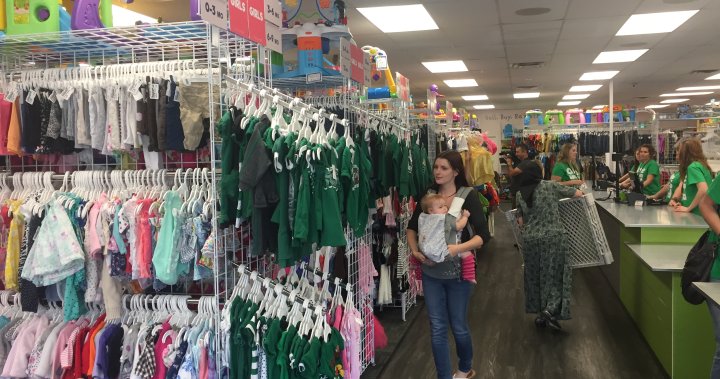Gently used backpacks, lunch boxes and other back-to-school gear have been flying off the shelves this summer at a Toronto children’s store, one employee says.
And it comes as a recent survey suggests consumers are trying to pull back on spending for the back-to-school season amid inflation and the high cost of living.
Once Upon a Child is a Canadian store that buys and sells gently used kids’ clothing and toys. Kate Young, marketing director of the store’s Leaside location, says demand has been reaching new heights since last year.
“I would certainly say we’re up in sales this year because I think people are realizing they don’t have as much money to spend. Everything is costing so much,” Young told Global News.
A study by Deloitte Consulting last year found that the average bill for back-to-school shopping in Canada came out to $700 per student, while a survey from the firm released last month suggested the cost of school supplies has increased 24 per cent over the last two years amid inflation.
This year, the firm expects consumers to spend less – $597 – on school supplies as people across income brackets deliberately try to pull back on back-to-school spending.
According to the Deloitte survey, cost consciousness also means fewer families are looking for sustainable school supplies, and plan to cut back on clothes purchases and tech to keep the focus on school supplies.
Annual inflation rose to 3.3 per cent nationally last month, Statistics Canada said Tuesday, which falls outside the central bank’s one-to-three per cent target range. That’s up from June’s inflation rate of 2.8 per cent.
“Maybe (parents) realize, ‘Why am I spending so much money on a brand new Nike backpack when there are other options?’ You don’t need to buy brand new every year for multiple children,” Young said.
According to Young, Once Upon a Child offers most items at around 70 per cent reduction less than the retail price. While sales dropped during the pandemic, Young says last year was the first time she’d experienced customers specifically requesting back-to-school products in the store.

A survey conducted by the Retail Council of Canada found that one in four Canadians will go back-to-school shopping this year.
Almost 74 per cent of Canadians plan to spend more than $50 but the number of people planning to spend less than that has gone up by 3.4 per cent compared to 2022.
“As our annual back-to-school shopping survey shows, this year, Canadians continue to be cautious of how they spend their money because of higher interest rates and inflation, but they continue to spend on basics and necessities for their family when it matters,” says Michelle Wasylyshen, a spokesperson for the Retail Council.
The study also found that people plan to focus their purchasing on lower-priced items than in years past. Stationery is expected to be the top spending category at 60.8 per cent, which the council says is noteworthy because the product did not make the 2022 list at all.
More on Canada
Clothing comes in as the second-highest spending category, at 32.1 per cent.
A new online study by NerdWallet Canada further shows how the economic pinch is squeezing wallets this year.
Twenty seven per cent of Canadians say they will purchase fewer back-to-school supplies for their children this year than in previous years due to inflation. More than half of parents say they plan to shop during sales for those purchases.
Fourteen per cent of participants said they anticipate they will go into debt to pay for back-to-school shopping, for example, through credit cards or personal loans.

Global News spoke with one kindergarten teacher with the York Region District School Board who says she plans to shop more cautiously for classroom supplies this year.
“I really do think about what I need to buy now because things are so expensive. I either look for sales or deals, or think about if I really even need it,” said Samantha, who asked to be identified only by her first name. “So inflation has definitely brought those thoughts, whereas before I would just get something if I wanted it. Now it’s not as easy.”
She added: “A lot of the stuff I buy for back-to-school has been from the dollar store, but it’s not really a dollar anymore. It’s like four or five dollars a lot of the time.”
Samantha has been teaching with the school board for nearly a decade. She says she has always made the most of the school’s budget and even her own money to prepare her classroom. However, she says the school board’s supply budget for teachers doesn’t feel like it has kept up with rising costs of living and working.
“If (the budget) has increased, I don’t think they’ve increased the amount that inflation has increased,” Samantha said.
© 2023 Global News, a division of Corus Entertainment Inc.



